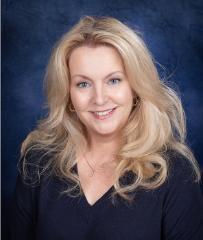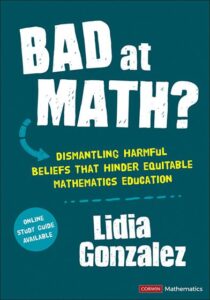Changing Harmful Beliefs about Math Education
Bad at Math? Dismantling Harmful Beliefs That Hinder Equitable Mathematics Education
By Lidia Gonzalez
(Corwin, 2023 – Learn more)
Reviewed by Kathleen Palmieri
 Lidia Gonzalez starts off Bad at Math? Dismantling Harmful Beliefs That Hinder Equitable Mathematics Education by asking “What does it mean to be good at math?” Delving into commonly held beliefs, discussing productive struggle and growth mindset sets the tone for a thoughtful look at what can be done to make math accessible to all students.
Lidia Gonzalez starts off Bad at Math? Dismantling Harmful Beliefs That Hinder Equitable Mathematics Education by asking “What does it mean to be good at math?” Delving into commonly held beliefs, discussing productive struggle and growth mindset sets the tone for a thoughtful look at what can be done to make math accessible to all students.
The topic of “Textbook problems versus open problems” is one that over the past few years has come up in research and collegial conversations. Gonzalez describes the problems often used in classrooms as methodical, offering little in allowing students to think of different math strategies.
 “The kinds of problems we typically see in classroom settings might be good at getting students to practice a particular algorithm,” Gonzalez writes, “but they do not invite the type of open-ended problem solving that requires creativity, multiple approaches, and thoughtful study over a prolonged period. As a result, students fall victim to the false idea that they should know how to do math problems quickly.” (p 12)
“The kinds of problems we typically see in classroom settings might be good at getting students to practice a particular algorithm,” Gonzalez writes, “but they do not invite the type of open-ended problem solving that requires creativity, multiple approaches, and thoughtful study over a prolonged period. As a result, students fall victim to the false idea that they should know how to do math problems quickly.” (p 12)
Using open ended problems that allow students to play and manipulate numbers to problem solve helps to build students confidence in their math ability.
Beyond the concentration on brilliance
Productive struggle and growth mindset work together in helping to counteract the belief in mathematical “brilliance” or a “math mind.” Gonzalez writes, “If we believe brilliance is necessary for success in mathematics, brilliance is limited to few, and that brilliance cannot be taught, it is difficult to imagine a reality where many decide to study mathematics in our society.” (p. 22)
Students who productively struggle with a math problem and are of the belief that they will improve with practice have a growth mindset. This also applies to the teachers who believe that with persistence and practice math skills will improve. Productive struggle must be “normalized” in the classroom, and in turn it will support a growth mindset.
Chapter 4, “We Are All Math People,” and chapter 7, “Mathematics as a Gatekeeper to Future Success,” dig deeper into the misconceptions and inequalities that hinder math education. The idea of “math people” in chapter 4, brings out Gonzalez’s belief that math people do exist. She explains her belief by stating, “What I reject is the idea that they are few in number and somehow possess mathematical abilities beyond the average person. They are the average person.” (p 75)
Gonzalez goes on to expand upon the definition of math as the study of patterns, offering examples from young children’s recognition of patterns to patterns in our daily lives. She poses the question, “How is it that even those who enjoy patterns, logic, games, and puzzles will claim to be bad at math?” The answer, she believes, lies within the realm of what most think of as mathematics – the procedural, not the creatively solved. “As a result, we neglect to see much of the mathematics that we are, in fact, engaged in.” (p. 80)
The impact of math study on students’ future
Chapter 7, “Mathematics as Gatekeeper,” discusses the problematic role mathematics plays in future success. Testing such as high-stakes standardized tests can be the gatekeeper, or barrier, to a student’s success in college.
“In general only 5% of college students in the United States pass a gateway mathematics course in their first two years,” she writes, “yet without this course they cannot graduate from college (Complete College America, 2021). In some cases, this mathematics course might be a prerequisite to further courses needed for their degree.” (p. 110)
It’s time to rethink the role of mathematical testing and how it affects future success. This leads right into the topic of “Achievement Gaps or Opportunity Gaps” in chapter 8.
Chapter 11, the final chapter, asks “Where do we go from here?” and considers the change that needs to happen. The change is not just in the product but in our perception of math itself. Gonzalez states, “Until we realize that mathematical is political, we will continue to believe that we are supporting all students while centering mathematics instruction on the experiences of the mainstream. Let us begin by pledging to eradicate the belief that it is socially acceptable to admit one is bad at math and move from there, as there is much work to be done.” (p. 170)
Each chapter ends with reflective questions, basically inviting educators to use their thoughts and voice for change. People who purchase the book can access a study guide at resources.corwin.com/badatmath for collegial book talks and to help make changes in mathematics education.
Read Lidia Gonzalez’s article for MiddleWeb here.
Kathleen Palmieri is a proud, renewed National Board Certified Teacher (Generalist/Middle Childhood) and NBCT Professional Learning facilitator. She is a fifth grade educator in upstate New York who reviews and writes regularly for MiddleWeb. With a passion for literacy and learning in the classroom, she participates in various writing workshops, curriculum writing endeavors, and math presentations. As a lifelong learner, she is an avid reader and researcher of educational practices and techniques. Collaborating with colleagues and globally on X (formerly Twitter) and expanding her education adventures at www.kathleenpalmieri.com are ongoing practices.



































